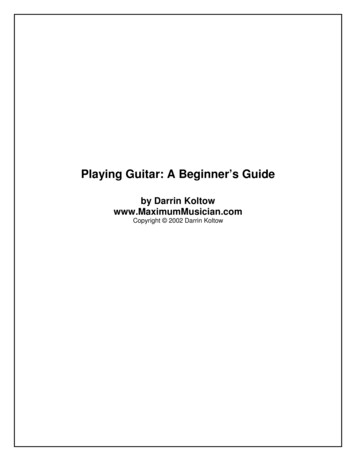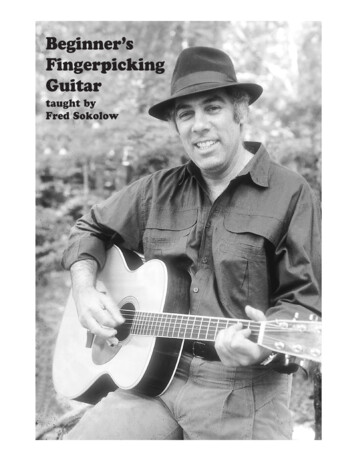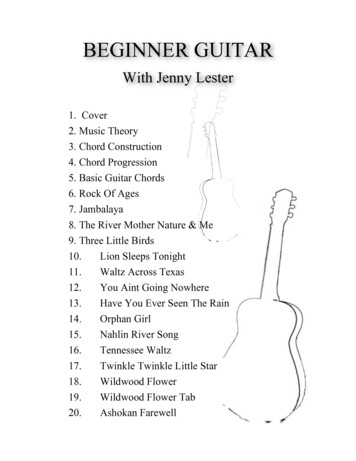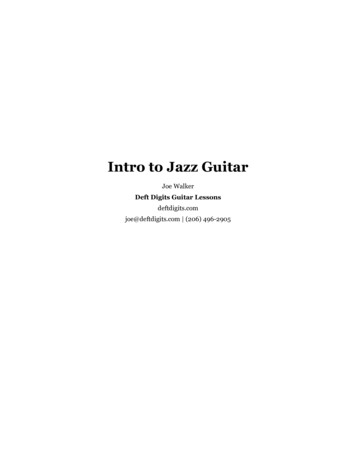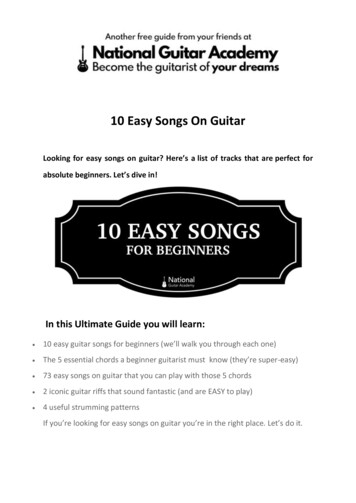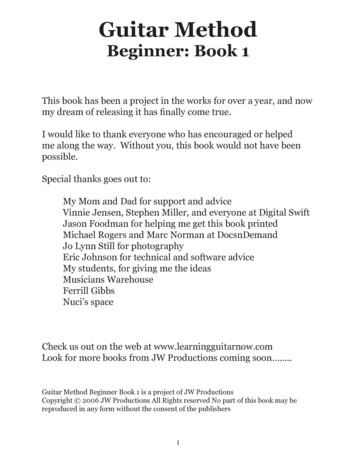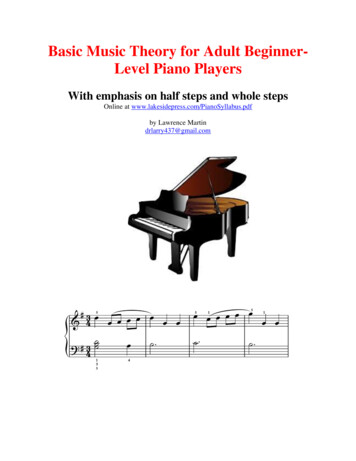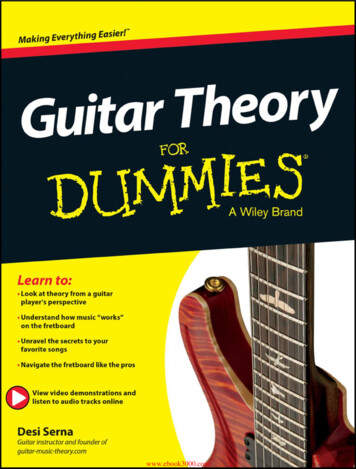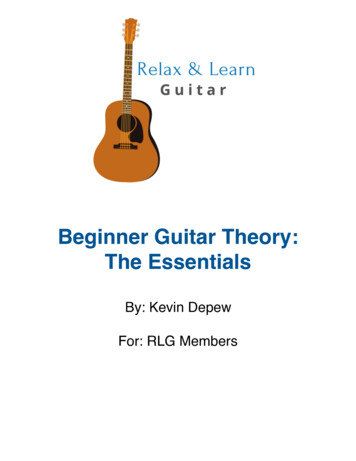
Transcription
Beginner Guitar Theory:The EssentialsBy: Kevin DepewFor: RLG Members
Beginner Guitar Theory - The EssentialsRelax and Learn Guitar’s theory of learning guitar:There are 2 sets of skills:Physical skills: getting your hands and fingers to be able to do what you want them to do soyou can: pick, strum, play chords, scales and solos, smoothly.Mental skills: This is your music theory knowledge, fretboard knowledge, applying yourself tobe a better guitar player.The mental skills that you develop will serve you very well. Ultimately, you want to get to thepoint that you know what to do and when to do it with all of the physical skills you have learned.Physical skillsEssential physical skills and developmentFor most right handed people:Left Hand fingering chords, scales, licks and solos. This is “what you know”Right hand strumming and picking, palm muting, dynamics. This is “who you are”Agility and coordination between both hands does take some time to achieve. There is nomagic pill. You will have to practice a little bit each day. This is because you are training yourmuscles to do something that they have not done before.Eventually it will become automatic and you won’t have to even think about it. And then you canfocus on what you are playing and not just how you are playing it.It is important to start with good habits to avoid developing a bad habit that will be hard to break.Here are some important things to be aware of: Hold your guitar correctlyPractice good posturePay attention to the way you are holding your hands and fingers and play in a relaxed style.Hold your pick with authorityStrum in timeOnce you have all of these essential physical skills down you can move on to advancedphysical skills.
Advanced physical skillsThese include: Playing patterns. Which is simply groups of things such as: Chord patternsScale patternsTriad patternsLicks and riffsThese patterns are almost always played over a series of chords knows as a chord progression.This is where the majority of your practice will take place once you have the essentials down.Musicians are always practicing playing over chord progressions in all kinds of keys. And youcan do this too to as you begin to get some command over your guitar.You will also learn how to add some style to your playing with slides and bends and vibrato,hammer ons, pull offs, harmonics, and dynamics.If you take some time to get all of this right at the beginning, it will pay off for you big time downthe road!Mental SkillsUnderstanding basic music theory will give you a structure and purpose to what you arelearning.The 4 important parts of music theory that we will cover in this document are:1.2.3.4.How the major scale is madeHow chords are made from the notes in a scaleHow chord progressions are used in the songs you want to learnThe timing you will use to strum these chord progressions in rhythm.1. ScalesFirst we will talk about the Major Scale:Scales are groups of notes played in an ascending or descending order of pitch.The notes in western music include 7 notes:A BC D E F G
There are many different scales, we will focus on the most common, the major scale. The majorscale sounds pleasant and if you have ever seen the movie The Sound of Music, it is the scalethat most people recognize as: do, re, mi, fa, so, la, ti, do.The major scale has been used to create more tunes than any other scale. It provides thebackdrop for standard music theory as we know it.There are 7 notes in the major scale. You start on the root note.- the first note of the scaleand the note the scale is named after. And when you get to the 8th note, you get an octavethis note is twice as high as the root note.Each note in a scale is separated by an interval. The smallest interval between two notes iscalled a semitone. Also known as a half step. On your guitar, each fret is one semitone.2 semitones 2 half steps.2 half steps 1 whole step2 semitones 1 tone1 tone whole step.A semitone is the same thing as a half step. A tone is the same thing as a whole step.The major scale always follows the same pattern, and you will generally see it explained likethis:W W H W W W HW 1 whole step, or 2 semitones or 2 fretsH 1 half step, or 1 semitone or 1 fret.So the C major scale is:rootvCoctavevD E F G A B C W W H W W W H
The “Note Circle” is a useful diagram to use to learn about semi tones (half steps, 1 fret) andtones (whole steps, 2 frets).There are 12 possible major scales because there are 12 semitones (half steps) between eachoctave on the note circle. In other words, there are 12 semitones moving from C clockwisearound the circle.A sharp (#) is a note higher (sit on a sharp tack, you jump up) in pitch by one semitone (halfstep, or fret)A flat (b) is a note lower (when you have a flat tire it goes down) in pitch by one semitone (halfstep, or fret).You will notice that some frets, or notes, can have 2 different names. This is because itdepends on what “direction” you are going in the scale.
2. ChordsWhen you learn to play the guitar, chords are usually the first thing on your mind. You have tolearn where to put your fingers the strings and which frets form which chords.As we have discussed, there are 7 notes in the major scale.A chord is a group of notes, usually a triad (group of 3). In the major scale, chords are madeup of the first, third and fifth notes of the scale.So a C major chord would be:C - 1st note of the scale, the E- 3rd note of the scale and G- the 5th note of the scaleFor each of the 7 notes in a scale, we build a chord. Therefore there are seven chords in thescale, or key.When you play a song you play in a certain “key” which uses a scale as its basis. Scale andkey are almost interchangeable terms.There are 3 basic types of chords we will cover here are:1. Major2. Minor3. DiminishedIf you have ever been around musicians playing in a group, you have probably heard one of thethem say:Q: “What key are we playing this song in”you may hear someone answer:A: “C major”Now you know that there are 7 chords in the key of C major: C , D, E, F, G, A, BEach chord is named after a note in the scale.Now, some of these chords are major, some of them are minor and one of them is diminished.And, you guessed it, they follow a pattern:
The first chord in the major scale, in this case C, is always major (maj)The second chord in the major scale, in this case D, is always minor (min)The third chord in the major scale, in this case E, is always minor (min)The forth chord in the major scale, in this case F, is always major (maj)The fifth chord in the major scale, in this case G , is always major (maj)The sixth chord in the major scale, in this case A, is always minor (min)The seventh chord in the major scale, in this case B, is always diminished (dim)Every major key has the same pattern of chords - maj, min, min, maj, maj, min, dimThe next thing we need to do is number the chords in the scale. This will make things easier tokeep track of .I major, ii minor, iii minor, IV major, V major, vi minor, vii diminishedNotice that we are using roman numerals for numbering the chords. The is so we can denotethe major chords with upper case (capital letters) and minor chords with lower case letters.So now each chord in the scale has a name and a number.NOTE: You are probably wondering what that diminished chord is and why it is lower case. Thediminished chord is always the 7th (vii) chord and is similar to a minor chord. No reason toworry about that now, it is not used often. Generally the first 6 chords are used the most.This may all make more sense when you look at the table on the next page .
The 12 keys are listed down the left column in red. Find the key, then read across left to right tofind the chords.Major chords are green and minor chords are blue.3. Chord ProgressionsThe benefit of using numbers for chords is that you can describe a chord progression moreuniversally.A chord progression is a combination of chords, in groups of 2, 3 or 4 chords together(usually).When we play a chord progression we don't call it the C, F, G chord progression.Instead we use numbers .We say ”That is a one, four, five chord progression. Which iscoincidentally one of the most used chord progression in music .ever.
All you do is look down the column and find the key that you want, then look under the I, IV, andV columns to find out what chords you should play.For example, here are some of the I. IV, V progressions in different keys:C majorG majorD majorICGDIVFCGVGDAAnother common chord progression is the I, V, vi, IVC majorG majorD majorICGDVGDAviAmEmBIVFCGThere are many different chord progressions that are used over and over in many hundreds ofsongs.Learning to play common chord progressions in different keys is excellent practice.Step 1: Practice the “basic” chords in the progression first. By basic I mean major and minor.Step 2: Learn how to extend those chords- playing suspended and 7th chords for example.Step 3- Learn barre chords so you can play in any key.Step 4- learn scales so that you can eventually play solos and licks over the chord progressions.The idea is to start with very simple ideas and then learn to build on those with more involvedskills and ideas. But the work is always done over a chord progression. This is whatprofessional players do all the time, they practice chord progressions in all the keys and how toapply new chords and new soloing ideas.
4. TimingNow, when you are playing these chord progressions it is super important to strum in time.This comes with practice.And it is helpful to have some basic timing knowledge. Including beats, measures (bars)and time signatures.Beats are used as a way for counting time when playing guitar. Beats give the music its regularrhythmic pattern.Beats are grouped together into a measure or bar. The grouping of beats is called a meter, ortime signature. Many things in music have more than one name.A time signature is written as 2 numbers, like a fraction.The top number tells you the number of beats in the bar; the bottom number tells you the notethat gets one beat.There are a couple of different time signatures. We are going to talk about 4/4 time, orcommon time. It is used the most often in music.The 4/4 time signature means there are 4 beats in the bar- top number. For example, 4 quarternotes ( 4 beats) in a bar. The bar will have a count of 1,2,3,4.The bottom number tells us that the quarter note gets one beat.You can add eighth notes ( 1/2 beat each ) into the count of the bar you have a count of 1 & 2&3&4&Strum patterns are all about when you strum while counting. A good starting point for much ofthe music we will play is to: Strum down on the “numbers" and strum up on the “ands”.Use the figure below to get a visual of the way notes are counted in 4/4 time:
This should give you a good foundation of the mental skills or music theory that you will need tobegin to master your guitar.However, it will do you no good if you do not apply it. YOU MUST PRACTICE.When you practice, you begin to attach these concepts and words and pictures to theinstrument and make the connections. Much like you need to train your muscles, you need totrain your brain.THERE IS SO MUCH INFORMATION OUT THERE!AVOID PARALYSIS BY ANALYSIS.The concepts in this short music theory PDF are all you need to get started and will take you along way.There are no magic pills or magic bullets to learning guitar.If you always remember the basics, you will always be in control. You can avoid the frustrationand confusion of information overload.Keep working on the basic chords, progressions and strumming in time. Build from there.Apply everything you learn to the songs you play. I truly believe that the best way to learn is torelax, take it slow, and learn lots of songs. That is really what counts in the end.
5. Some Helpful Bonus Hints.Here are a few more helpful hints and a quick glossary of terms:It will serve you well to memorize the notes on the 6th snd 5th strings of the guitar:
And the notes of the open strings:Glossary of terms:BarAlso called a measure. A measurement or group of beats.Beats Used as a way for counting time when playing guitar. Beats give the music its regularrhythmic pattern.Barre chords Chords created by placing your index finger flat across the strings at a single fretwhile the other fingers form shapes on the frets further up the neck. Barre chords allow you toplay in any key.Chord is a group of notes played together, usually a triad (group of 3). In the major scale,chords are made up of the first, third and fifth notes of the scale.
Chord ProgressionA combination of chords, in groups of 2, 3 or 4 chords togetherCommon Time4/4 time signature.FlatA note lower in pitch by one semitone or half step.KeyThe tonal center of a song.Major Scale The basic building block of music theory, the major scale begins on one note andalways follows this pattern. There are 7 notes in the scale.root - whole step - whole step - half step - whole step - whole step - whole step- has step(the root again now an active up)NoteA musical tone or a specific pitchOctaveAn interval of 6 full steps, which is 12 half steps from the root note, always hasthe same name as the root note.Root noteThe note named by a chord. The C is the root note of the C major chord. Alsothe first note in a scaleSemitoneA half step, or one fretSharp A note higher in pitch by one semitone or half stepTime signature. Usually looks like a fraction. The top number tells you how many beats in thebar. The motto number tells you which type of note gets one beat.ToneA whole step, or two frets
There are 12 possible major scales because there are 12 semitones (half steps) between each octave on the note circle. In other words, there are 12 semitones moving from C clockwise around the circle. A sharp (#) is a note higher (sit on a sharp tack, you jump up) in pitch by one semitone (half step, or fret)


